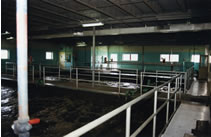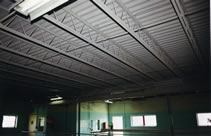The tiny community of Machias, Maine, just 30 miles from the Canadian border, is home to 3,000 hardy souls. They have learned to live with the region's harsh climate. It has been more difficult for the town's water treatment plant. That's why Machias chose ZRC to protect the acid-exposed ceiling of the plant from corrosion.
Paint Was Not Enough
The Machias Water Treatment Plant was built in 1972, and serves the entire population of the town. Constant exposure to an actively corrosive atmosphere had caused severe rusting of the plant's ceiling. Officials had planned to sandblast, then apply two coats of epoxy in an effort to save the ceiling. But Roy Love, a resident of Machias and president of Love's Painting Company, pointed out that epoxy alone would not provide long term service in an atmosphere full of vapors from chlorine, lime and other corrosive elements. In fact, the paint itself was reacting with acids in the treated water.
Based on his experience with ZRC in other challenging applications, Love recommended the 95% zinc rich primer as the most effective and efficient way to prevent acid attack and rust. Love's Painting had used ZRC on the metal roof of the Machias Memorial High School in 1986, and the roof was still rust tree in 1991. The town approved Love's proposal.
The ceiling was sandblasted to near-white metal (SSPC-SP10). Two coats of ZRC were applied, with no topcoat. The project was completed in July, 1991. The ceiling is expected to stay in excellent condition with no rust or corrosion damage for a minimum of five years.
The ZRC Difference
Why did ZRC work where epoxy paints failed? ZRC provides the galvanic protection of zinc, and acts as a physical barrier against contaminants. As the zinc content of ZRC is sacrificed to prevent rust from starting, insoluble corrosion by-products are formed. These by-products fill voids and pores in the zinc primer film, forming an insoluble barrier to further protect against attacks on the zinc film and steel substrate. Many of these by-products also tend to inhibit the rusting process by increasing the pH level.
Unlike ordinary paint, ZRC continues to provide protection against rust and rust creepage even if the protected surface is scratched to the bare metal. The zinc forms a layer of insoluble zinc salt over the exposed area, "healing" the break and providing protection against corrosion. Due to these properties, ZRC is often specified for applications in water, waste and chemically active environments and other locations where highly corrosive acids and vapors are present.
The people of Machias, Maine are happy that ZRC has what it takes to solve their rust and corrosion problems.



